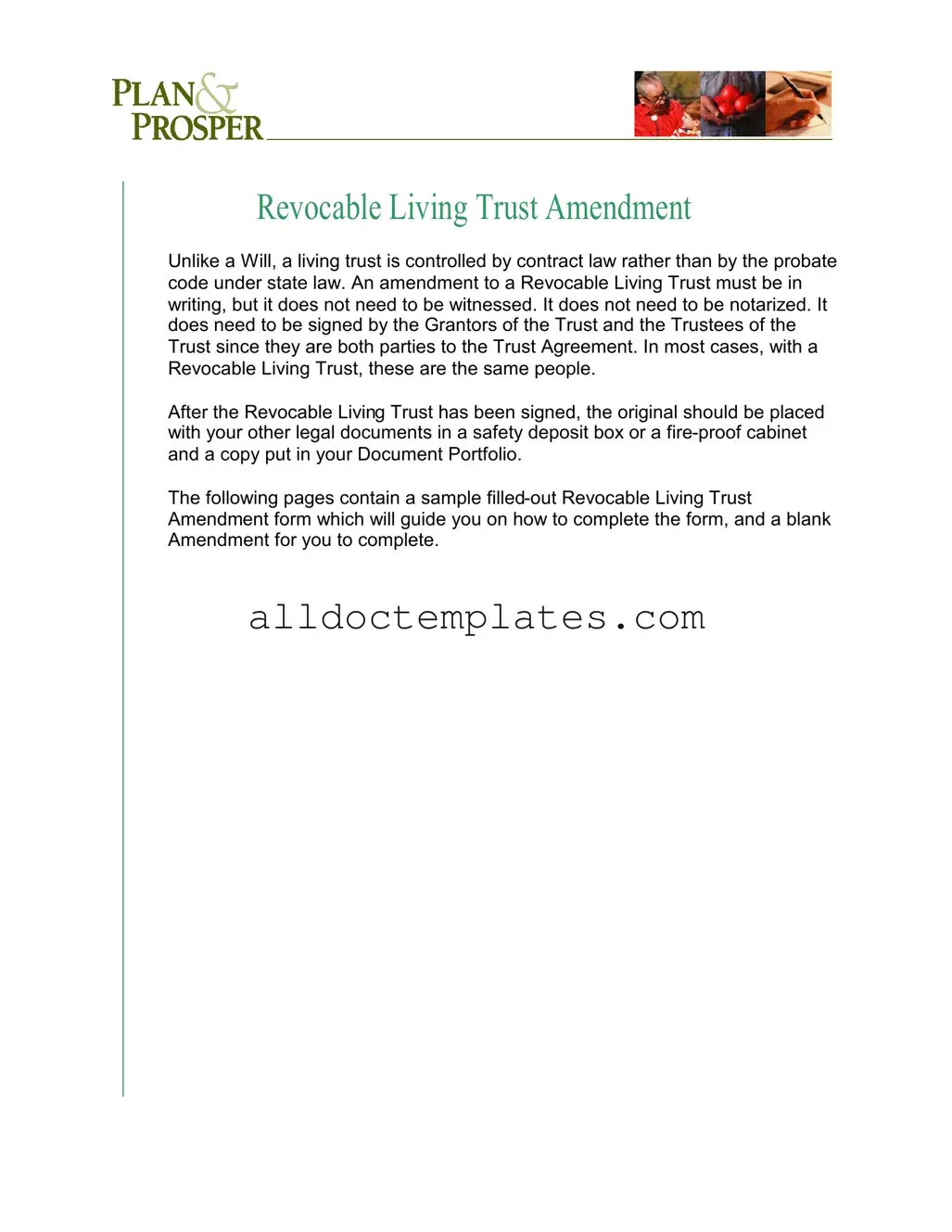Revocable Living Trust Amendment
Unlike a Will, a living trust is controlled by contract law rather than by the probate code under state law. An amendment to a Revocable Living Trust must be in writing, but it does not need to be witnessed. It does not need to be notarized. It does need to be signed by the Grantors of the Trust and the Trustees of the Trust since they are both parties to the Trust Agreement. In most cases, with a Revocable Living Trust, these are the same people.
After the Revocable Living Trust has been signed, the original should be placed with your other legal documents in a safety deposit box or a fire-proof cabinet and a copy put in your Document Portfolio.
The following pages contain a sample filled-out Revocable Living Trust Amendment form which will guide you on how to complete the form, and a blank Amendment for you to complete.
THE
REVOCABLE LIVING TRUST
AMENDMENT
THIS |
|
|
|
|
AMENDMENT to the Trust Agreement made this |
|
|
|
day of |
, |
|
|
|
|
executed between |
|
|
|
|
|
|
|
|
|
|
|
|
|
|
|
|
|
|
, hereinafter |
referred to as the Grantor(s) and |
|
|
|
|
|
|
, |
hereinafter referred to as the Trustee(s). |
|
|
|
|
|
|
|
|
WHEREAS, the Grantor(s) and the Trustee(s) entered into a Revocable Living Trust
dated, hereinafter called the Trust Agreement, and
WHEREAS, Articleof the Trust Agreement provided that the
Grantor(s) reserve(s) the right to amend in any manner or revoke in whole or in part the Trust Agreement, and
WHEREAS, the Grantor(s) is/are desirous of modifying and amending the Trust Agreement and the Trustee(s) is/are agreeable to the modification and amendments contained herein,
NOW THEREFORE, IT IS AGREED:
IN WITNESS WHEREOF, Grantor(s) has hereunto subscribed his/her name |
to the |
Amendment to this TRUST this day of |
, 20 |
. |
|
|
|
|
|
|
|
|
|
|
|
|
GRANTOR |
|
|
|
|
|
STATE OF |
) |
|
|
|
|
|
) SS |
|
|
|
|
COUNTY OF |
) |
|
|
|
|
The foregoing instrument was acknowledged before me this |
|
day of |
, |
|
|
|
|
|
|
20, by the Grantor.
SEAL
Notary public:
My Commission Expires:
THE
REVOCABLE LIVING TRUST
AMENDMENT
THIS |
AMENDMENT to the Trust Agreement made this |
|
|
|
day of |
, |
executed between |
|
|
|
|
|
|
|
|
|
|
|
, hereinafter |
referred to as the Grantor(s) and |
|
|
|
|
|
|
, hereinafter |
referred to as the Trustee(s). |
|
|
|
|
|
|
WHEREAS, the Grantor(s) and the Trustee(s) entered into a Revocable Living Trust
dated, hereinafter called the Trust Agreement, and
WHEREAS, Articleof the Trust Agreement provided that the
Grantor(s) reserves the right to amend in any manner or revoke in whole or in part the Trust Agreement, and
WHEREAS, the Grantor(s) is desirous of modifying and amending the Trust Agreement and the Trustee(s) is agreeable to the modification and amendments contained herein,
NOW THEREFORE, IT IS AGREED:
IN WITNESS WHEREOF, Grantor(s) has hereunto subscribed his/her name to the
Amendment to this TRUST this |
|
day of |
, 20 |
. |
|
|
|
|
|
|
|
GRANTOR |
|
|
|
|
|
STATE OF |
) |
|
|
|
|
|
) SS |
|
|
|
|
COUNTY OF |
) |
|
|
|
|
The foregoing instrument was acknowledged before me this |
|
day of |
, |
|
|
|
|
|
|
20, by the Grantor.
SEAL
Notary public:
My Commission Expires:





